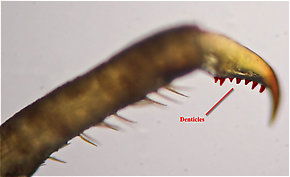Blog & Latest Updates
Fly Fishing Articles
Insects by Common Name


> > Green Lake Outlet
Landscape & scenery photos from Green Lake Outlet
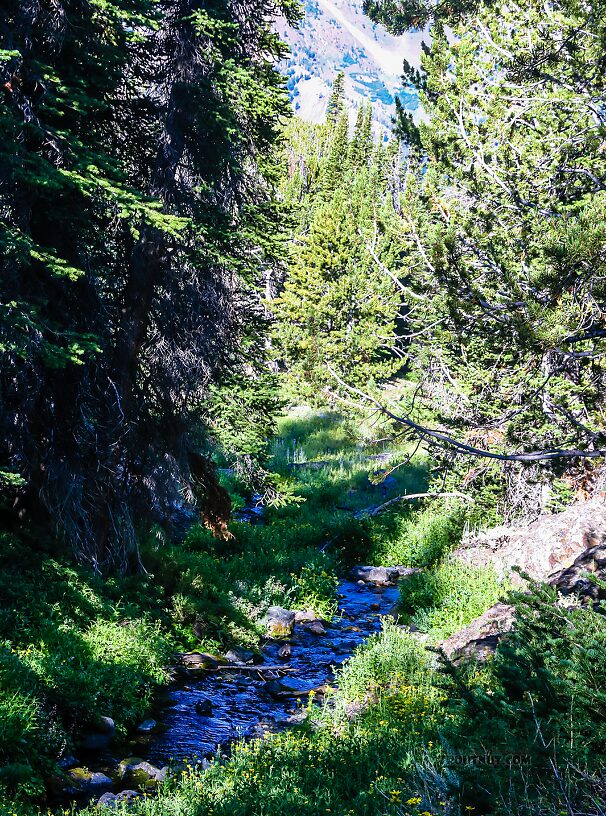
StateIdaho
LocationGreen Lake Outlet
Date TakenAug 4, 2020
Date AddedAug 19, 2020
AuthorTroutnut
CameraCanon EOS 7D Mark II

StateIdaho
LocationGreen Lake Outlet
Date TakenAug 4, 2020
Date AddedAug 19, 2020
AuthorTroutnut
CameraCanon EOS 7D Mark II

StateIdaho
LocationGreen Lake Outlet
Date TakenAug 4, 2020
Date AddedAug 19, 2020
AuthorTroutnut
CameraCanon EOS 7D Mark II
Closeup insects from Green Lake Outlet
Baetis bicaudatus (BWO) Mayfly Nymph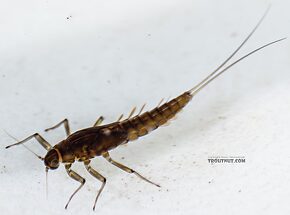 View 5 PicturesHere I'm just copying and pasting, without cleaning up, my notes from spending a long time with this one under the microscope (and keying with Merritt & Cummins 5th Ed) only to end up confirming the most likely guess.
View 5 PicturesHere I'm just copying and pasting, without cleaning up, my notes from spending a long time with this one under the microscope (and keying with Merritt & Cummins 5th Ed) only to end up confirming the most likely guess.
7. Baetis bicaudatus nymph
1. Hind wingpad present but small and hidden beneath forewing pad
2. Segment 2 of labial palp (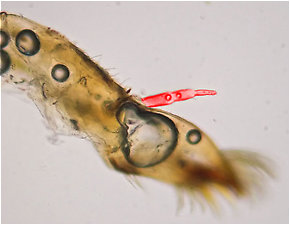 Palp: A long, thin, often segmented appendage which can protrude from certain insect mouth parts such as the maxillae. Also known as the < />palpus.) with well-developed medially projecting corner —> Baetis (couple 44)…. BUT no sign of scale-like setae (Seta: Little hairs on insects.) on abdominal terga (Tergum: the dorsal part of an abdominal segment or segments (terga). Also used to describe the entire abdominal dorsum or the thoracic dorsal segments of Odonata.). Conflicts at this couplet.
Palp: A long, thin, often segmented appendage which can protrude from certain insect mouth parts such as the maxillae. Also known as the < />palpus.) with well-developed medially projecting corner —> Baetis (couple 44)…. BUT no sign of scale-like setae (Seta: Little hairs on insects.) on abdominal terga (Tergum: the dorsal part of an abdominal segment or segments (terga). Also used to describe the entire abdominal dorsum or the thoracic dorsal segments of Odonata.). Conflicts at this couplet.
3. Gills on segments I-VII
4. Tarsal claws (Tarsal claw: The claws at the tip of the tarsus, on an insect's "foot.") with denticles (Denticle: Small tooth-like projects, often appearing like serrations on the tarsal claws of certain mayfly nymphs.), seemingly 2 rows but very hard to tell… and the key options with 2 rows don’t make sense
5. Assuming no villipore, we land confidently at couplet 48
6. Leads to Fallceon, except antennal scape doesn’t have robust setae (Seta: Little hairs on insects.)
7. Treated as Baetis, leads to brunneicolor, but McDunnough et al 1932 (Can Ent 64) suggests middle tail should be 5/6 as long as outer ones
8. Keys VERY confidently to couplet 36 in M&C (villipore)
9. If assuming villipore present:
1. 37 —> Scape of anntenae has no distal (Distal: Far from the point of attachment or origin; near the tip.) lobe —> rules out Labiobaetis (100 % certain)
2. 38 —> Terminal filament much shorter than cerci (Cercus: The left and right "tails" of an insect are known as the cerci or caudal cerci. The middle tail of a three-tailed insect is not.) —> not Barbaetis benfieldi (100 % certain)
3. 39 —> Terminal filament reduced (100 % certain)
4. 40 —> Tarsal claw (Tarsal claw: The claws at the tip of the tarsus, on an insect's "foot.") dentical count couplet. If two rows of denticles (Denticle: Small tooth-like projects, often appearing like serrations on the tarsal claws of certain mayfly nymphs.): Either Iswaeon or Heterocloeon. Can’t be Iswaeon because cerci (Cercus: The left and right "tails" of an insect are known as the cerci or caudal cerci. The middle tail of a three-tailed insect is not.) lack dark median band. Can’t be heterocloeon because it’s not in the Platte drainage or in Texas. Thus, it must be one row of denticles (Denticle: Small tooth-like projects, often appearing like serrations on the tarsal claws of certain mayfly nymphs.). Moving on to 42.
5. 42 —> Hind wing pads (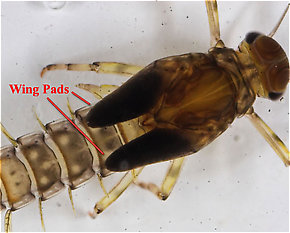 Wing pad: A protrusion from the thorax of an insect nymph which holds the developing wings. Black wing pads usually indicate that the nymph is nearly ready to emerge into an adult.) present (100 % certain)
Wing pad: A protrusion from the thorax of an insect nymph which holds the developing wings. Black wing pads usually indicate that the nymph is nearly ready to emerge into an adult.) present (100 % certain)
6. 44 —> Segment 2 of labial palpi with well-developed medially projecting corner (80 % certain), scale-like setae (Seta: Little hairs on insects.) not evident on terga (Tergum: the dorsal part of an abdominal segment or segments (terga). Also used to describe the entire abdominal dorsum or the thoracic dorsal segments of Odonata.) but maybe limitation of my scope —> Baetis (alternative would be Acentrella, but pronotum (Pronotum: The top of the insect prothorax.) shape is all wrong for those, although not an official characteristic)
7. CONFIDENT in Baetis bicaudatus after distinctive leg markings (J-shaped light mark on first femur (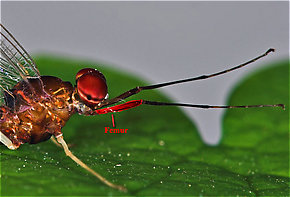 Femur: The main segment of an insect's leg close to the body, in between the tibia and the trochanter.), L-shaped on second and third) matches original species description to a tee.
Femur: The main segment of an insect's leg close to the body, in between the tibia and the trochanter.), L-shaped on second and third) matches original species description to a tee.
 View 5 PicturesHere I'm just copying and pasting, without cleaning up, my notes from spending a long time with this one under the microscope (and keying with Merritt & Cummins 5th Ed) only to end up confirming the most likely guess.
View 5 PicturesHere I'm just copying and pasting, without cleaning up, my notes from spending a long time with this one under the microscope (and keying with Merritt & Cummins 5th Ed) only to end up confirming the most likely guess.7. Baetis bicaudatus nymph
1. Hind wingpad present but small and hidden beneath forewing pad
2. Segment 2 of labial palp (

The palp on the maxilla of an Ephemerella nymph (detached and photographed under a microscope) is highlighted in red here.
3. Gills on segments I-VII
4. Tarsal claws (Tarsal claw: The claws at the tip of the tarsus, on an insect's "foot.") with denticles (Denticle: Small tooth-like projects, often appearing like serrations on the tarsal claws of certain mayfly nymphs.), seemingly 2 rows but very hard to tell… and the key options with 2 rows don’t make sense
5. Assuming no villipore, we land confidently at couplet 48
6. Leads to Fallceon, except antennal scape doesn’t have robust setae (Seta: Little hairs on insects.)
7. Treated as Baetis, leads to brunneicolor, but McDunnough et al 1932 (Can Ent 64) suggests middle tail should be 5/6 as long as outer ones
8. Keys VERY confidently to couplet 36 in M&C (villipore)
9. If assuming villipore present:
1. 37 —> Scape of anntenae has no distal (Distal: Far from the point of attachment or origin; near the tip.) lobe —> rules out Labiobaetis (100 % certain)
2. 38 —> Terminal filament much shorter than cerci (Cercus: The left and right "tails" of an insect are known as the cerci or caudal cerci. The middle tail of a three-tailed insect is not.) —> not Barbaetis benfieldi (100 % certain)
3. 39 —> Terminal filament reduced (100 % certain)
4. 40 —> Tarsal claw (Tarsal claw: The claws at the tip of the tarsus, on an insect's "foot.") dentical count couplet. If two rows of denticles (Denticle: Small tooth-like projects, often appearing like serrations on the tarsal claws of certain mayfly nymphs.): Either Iswaeon or Heterocloeon. Can’t be Iswaeon because cerci (Cercus: The left and right "tails" of an insect are known as the cerci or caudal cerci. The middle tail of a three-tailed insect is not.) lack dark median band. Can’t be heterocloeon because it’s not in the Platte drainage or in Texas. Thus, it must be one row of denticles (Denticle: Small tooth-like projects, often appearing like serrations on the tarsal claws of certain mayfly nymphs.). Moving on to 42.
5. 42 —> Hind wing pads (

The wing pads on this final instar Baetidae mayfly nymph are extremely dark.
6. 44 —> Segment 2 of labial palpi with well-developed medially projecting corner (80 % certain), scale-like setae (Seta: Little hairs on insects.) not evident on terga (Tergum: the dorsal part of an abdominal segment or segments (terga). Also used to describe the entire abdominal dorsum or the thoracic dorsal segments of Odonata.) but maybe limitation of my scope —> Baetis (alternative would be Acentrella, but pronotum (Pronotum: The top of the insect prothorax.) shape is all wrong for those, although not an official characteristic)
7. CONFIDENT in Baetis bicaudatus after distinctive leg markings (J-shaped light mark on first femur (

The femur of this Isonychia bicolor mayfly spinner is highlighted in red.
Collected August 4, 2020 from Green Lake Outlet in Idaho
Added to Troutnut.com by Troutnut on August 20, 2020
Added to Troutnut.com by Troutnut on August 20, 2020
Drunella coloradensis (Small Western Green Drake) Mayfly Nymph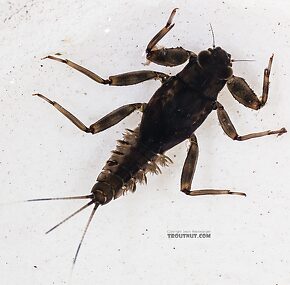 View 6 Pictures
View 6 Pictures
 View 6 Pictures
View 6 PicturesCollected August 4, 2020 from Green Lake Outlet in Idaho
Added to Troutnut.com by Troutnut on August 20, 2020
Added to Troutnut.com by Troutnut on August 20, 2020
Cinygmula (Dark Red Quills) Mayfly Nymph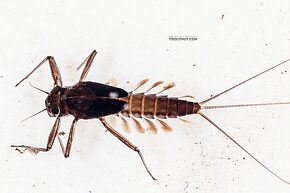 View 5 PicturesThis nymph was one of several mature Cinygmula nymphs collected at the same time as this female dun emerged, so they're probably the same species. Unfortunately there aren't species keys for either stage.
View 5 PicturesThis nymph was one of several mature Cinygmula nymphs collected at the same time as this female dun emerged, so they're probably the same species. Unfortunately there aren't species keys for either stage.
 View 5 PicturesThis nymph was one of several mature Cinygmula nymphs collected at the same time as this female dun emerged, so they're probably the same species. Unfortunately there aren't species keys for either stage.
View 5 PicturesThis nymph was one of several mature Cinygmula nymphs collected at the same time as this female dun emerged, so they're probably the same species. Unfortunately there aren't species keys for either stage.Collected August 4, 2020 from Green Lake Outlet in Idaho
Added to Troutnut.com by Troutnut on August 20, 2020
Added to Troutnut.com by Troutnut on August 20, 2020
Female Cinygmula (Dark Red Quills) Mayfly Dun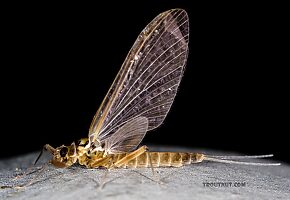 View 4 PicturesThis female dun emerged from a creek loaded with mature Cinygmula nymphs including this specimen, so they're probably the same species. Unfortunately there aren't species keys for either stage.
View 4 PicturesThis female dun emerged from a creek loaded with mature Cinygmula nymphs including this specimen, so they're probably the same species. Unfortunately there aren't species keys for either stage.
 View 4 PicturesThis female dun emerged from a creek loaded with mature Cinygmula nymphs including this specimen, so they're probably the same species. Unfortunately there aren't species keys for either stage.
View 4 PicturesThis female dun emerged from a creek loaded with mature Cinygmula nymphs including this specimen, so they're probably the same species. Unfortunately there aren't species keys for either stage.Collected August 4, 2020 from Green Lake Outlet in Idaho
Added to Troutnut.com by Troutnut on August 20, 2020
Added to Troutnut.com by Troutnut on August 20, 2020
Male Chloroperlidae (Sallflies) Stonefly Adult View 4 PicturesThis specimen unfortunately was blown away by the wind mid-way through the photographs, so I wasn't able to preserve it for an ID or get some of the other angles.
View 4 PicturesThis specimen unfortunately was blown away by the wind mid-way through the photographs, so I wasn't able to preserve it for an ID or get some of the other angles.
 View 4 PicturesThis specimen unfortunately was blown away by the wind mid-way through the photographs, so I wasn't able to preserve it for an ID or get some of the other angles.
View 4 PicturesThis specimen unfortunately was blown away by the wind mid-way through the photographs, so I wasn't able to preserve it for an ID or get some of the other angles.Collected August 4, 2020 from Green Lake Outlet in Idaho
Added to Troutnut.com by Troutnut on August 19, 2020
Added to Troutnut.com by Troutnut on August 19, 2020
Start a Discussion of Green Lake Outlet:
Top 10 Fly Hatches
Top Gift Shop Designs
Eat mayflies.
Top Insect Specimens
Miscellaneous Sites
Troutnut.com is copyright © 2004-2024 Jason
Neuswanger (email Jason). See my FAQ for information about use of my images.
 privacy policy
privacy policy

